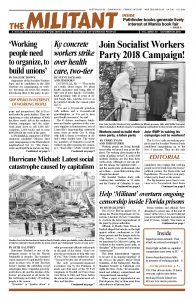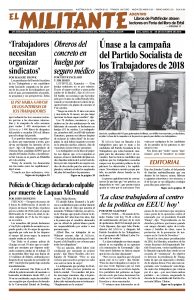November 1, 1993
Iowa State University in Ames, Iowa, recently surveyed more than 1,100 farm families in the state and identified close to a quarter as being in severe financial condition.
One of the “luxuries” to go is health insurance. Currently around 25 percent of Midwest farmers have little or no health insurance. The average farm family of four pays close to $4,500 a year for health care.
The July floods mean that Iowa farmers face the lowest crop yields in 30 years. In fact, the only way out for many farmers is to destroy thousands of acres of crops to qualify for the government’s “zero-92” program, under which 92 percent of farm-program payments are paid by the government if no crops are planted or if an existing crop is intentionally destroyed.
November 1, 1968
The presidential election campaign of the Socialist Workers Party, buttressed by local campaigns, has been the most effective waged by the party since it first fielded a presidential ticket in 1948. And if there was ever an election year when a meaningful socialist alternative to the capitalist politicians was needed, this certainly has been it.
Referring to Humphrey, Nixon and Wallace, an Oct. 24 New York Times story was headlined: “The Candidates and Foreign Affairs: Little Choice for Voters Seem Evident.”
This is the fact not only in relation in foreign affairs, but on every significant issue at stake in the election. All three favor continuing U.S. efforts aimed at world domination. All three favor repressive measures against liberation forces at home.
October 30, 1943
With thousands of rank and file coal miners again on strike against the wage-freezing policies of the Roosevelt war government, the War Labor Board rejected the second agreement negotiated between the Illinois Coal Operators Association and the United Mine Workers Union. As the miners battle to defend their standard of living, demands are growing for a general strike among the 1,450,000 railroad workers.
The crisis of railway labor can be better understood when it is recalled that the rail workers are accounted as one of the most conservative sections of the trade union movement. Today, however, the rank and file of the rail unions are fighting mad. They are demanding action and are proceeding to build some red hot fires underneath the ample posteriors of their “labor executives.”

